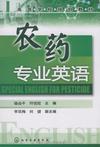农药专业英语
出版时间:2009-3 出版社:化学工业出版社 作者:骆焱平,符悦冠 主编 页数:245
Tag标签:无
前言
随着科学技术的不断发展,农药生产己由过去依靠单纯的天然获取转变为如今的有机合成,特别是高通量筛选和组合化学在农药生产中的应用,使得农药的开发速度不断加快,新的农药品种不断出现。然而,农药新品种、新技术大多是由跨国农药公司开发的,各种资料和文献主要以英语为载体,国内学者和广大农药学专业师生在查阅和参考相关数据时,如果没有扎实的专业英语知识,很难对国际农药学动向作全面的了解,也很难加以甄别和吸收。因此,学好农药学专业英语显得尤为重要。然而,目前国内并没有专门农药学专业英语教材,基于此,我们组织编写了这本《农药专业英语》。适用对象为植物保护、农药学等专业的本科生和研究生,也可作为参考资料供相关专业人士使用。 全书分为10个部分,共计20个单元40篇课文,分别介绍了化学农药、生物农药、农药毒理学、农药剂型、农药生物测定、农药残留分析、抗药性、农药使用技术、农药管理及农药环境与健康等方面的内容。全书内容丰富全面,专业词汇完备,每个单元后面均列有详细注释,并提供一定量的习题进行练习和巩固。书后附录包括常见农药专业英语词根、前后缀,农药剂型名称及代码,农药中英文名称。 本书从化学农药、生物农药到农药生物测定;从农药剂型、使用技术到农药管理;从农药毒理学、农药残留分析到抗药性,以及农药对环境和人类健康的影响等,均选编了相关文献,列举了大量专业词汇,希望能帮助广大学生对农药学专业英语有一个全面、系统和深入的了解,也希望他们在进一步的学习和工作中,能够熟练使用专业外语,这正是编者编写本书的目的之所在。
内容概要
本书是根据近年来农药学科的快速发展要求编写而成。分别介绍了化学农药、生物农药、农药毒理学、农药剂型、农药生物测定、农药残留分析、抗药性、农药使用技术、农药管理及环境与健康等方面内容。书后附录包括常见农药专业词根、前后缀,农药剂型名称及代码,农药中英文名称。 本书可供农药学专业的本科生和研究生使用,也可作相关专业人员的教学和参考用书。
书籍目录
PART I CHEMICAL PESTICIDES Unit 1 Chemistry of Pesticides Unit 2 Chemical Classes of InsecticidesPART II BIOLOGICAL PESTICIDES" Unit 3 Biopesticides Unit 4 Biopesticides Based on PhytochemicalsPART III TOXICOLOGY OF PESTICIDE Unit 5 Cholinesterases Unit 6 the Mode of Action of GlyphosatePART IV FORMULATIONS Unit 7 The Formulations of Pesticides (I) Unit 8 The Formulations of Pesticides (II)PART V BIOASSAYS Unit 9 Experimental Design of Bioassays Unit 10 Bioassays ofB. thuringiensisPART VI PESTICIDE RESIDUES Unit 11 Pesticide Residues in Food and International Trade Unit 12 Analytical Method of the Pesticide Residues.PART VII RESISTANCE Unit 13 Resistance to Pesticides Unit 14 Mechanisms of Resistance to PesticidesPART VIII APPLICATION OF PESTICIDES. Unit 15 Application Technologies. Unit 16 Delivery of Pesticides in AgriculturePART IX PESTICIDE MANAGEMENT Unit 17 Pesticide Management in China. Unit 18 Pesticide Regulation in USA……
章节摘录
Purification. The filtrate resulting from sample extraction is a complex mixturethat contains organic solvent(s), water, biochemicals (lipids, sugars, amino acids, andproteins), and secondary metabolites (organic acids, alkaloids, terpenoids, etc.) at highconcentrations with very minute amounts of the pesticide residues of interest. It is achallenging task to isolate and detect pesticide residues of interest in the presence ofhigh levels of background chemicals, often called matrix interferences. Most crudeextracts require some purification prior to analysis. Purification involves the removal of water, evaporation of excess organic solvent,and selective trapping to separate pesticides from interferences. The greater the numberof cleanup steps included in a method, the greater the losses of analytes and the longerit takes to carry out the analysis. Most of the water must be removed from the extract tofurther concentrate the desired analytes. Much water is quickly removed by partitioningthe organic solvent with sodium chloride-saturated water. These techniques removelarge amounts ofthe water, but the remaining traces of water must be removed byfiltering or adding dehydrated hygroscopic salts (e.g., Na2SO4) to the organic phase ofthe extract. Recoveries of extremely water-soluble pesticides such as acephate andmethamidophos can vary depending on the concentration of other solutes and themechanism of water removal. Even after the removal of many water-soluble coextractives, extracts still containlarge amounts of interfering compounds and only trace levels of pesticide residues.Buffering the aqueous phase close to a pH of 7 prior to removing water causes moreionic and polar biochemicals to partition into the water and results in removing largequantities of organic acids from the organic phase, which contains neutral and nonpolarchemicals, including pesticide residues. It is also possible to remove large amounts ofnonpolar plant constituents before removing the water by filtering the aqueous/organicextract through reversed-phase solid-phase extraction (SPE) material or an activatedcarbon sorbent. Because extracts must be concentrated lO0-fold or more, a requirement for traceresidue analyses, rapid and efficient concentration techniques are preferred. Rotaryevaporators and Kudema-Danish sample concentrators are good for concentratingthermally labile and highly volatile pesticides. Heating the extract in an open beakerwith a stream of gas is also an efficient and inexpensive way to achieve concentration.
图书封面
图书标签Tags
无
评论、评分、阅读与下载
用户评论 (总计6条)
- 全英文专业英语文章,后有词库,适合自学,也适合高校学生上课使用。
- 还没看,但愿不错
- 发货很及时,包装很好。
- 这本书还不错,帮我学习更多专业外语
- 不太清楚好不好,需要又没有这种题材的,先买了学习学习再说吧。
- 很适合从事农药相关专业的人员阅读,初步了解一些农药英语内的专业词汇和说法!
